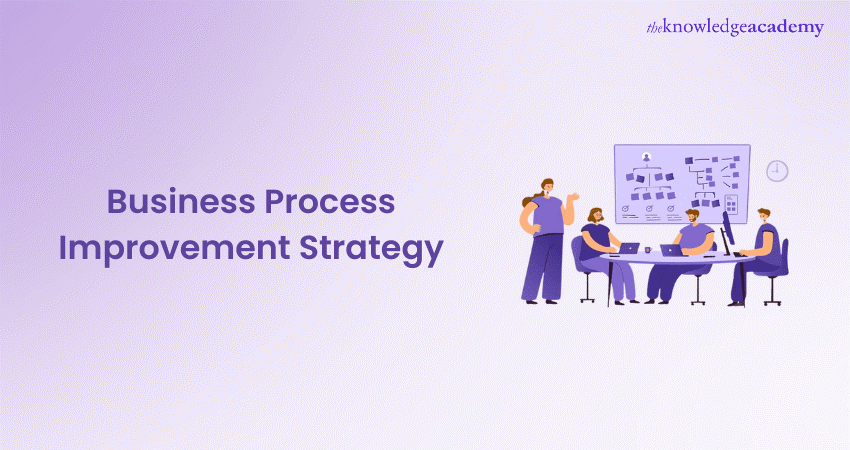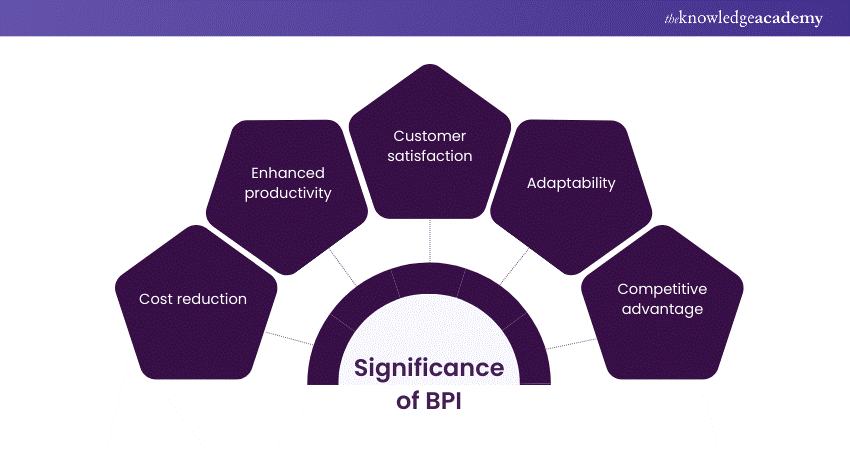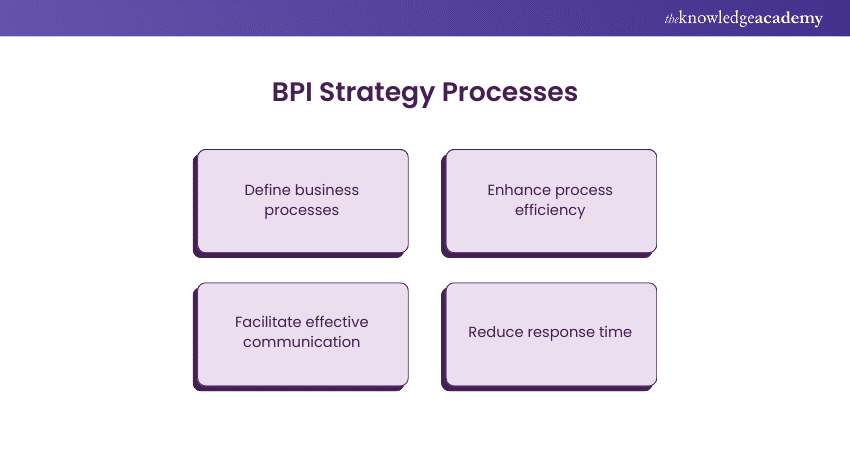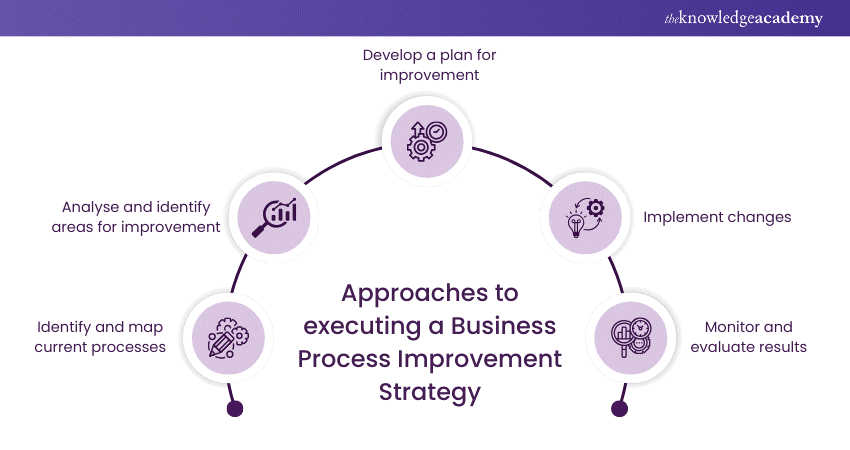We may not have the course you’re looking for. If you enquire or give us a call on +852 2592 5349 and speak to our training experts, we may still be able to help with your training requirements.
Training Outcomes Within Your Budget!
We ensure quality, budget-alignment, and timely delivery by our expert instructors.

To improve their efficiency, each organisation must employ a critical method called the Business Process Improvement Strategy. This process analyses strategically designed systems to introduce purposeful business improvement processes. In addition, it helps organisations to ensure efficient use of decision-making and innovation. Moreover, such a way assists individuals to avoid making incorrect decisions that are not suitable to any specific scenario.
While finding the problems in the BPI is the main key, an organisation must realign itself to attain common goals. To help you comprehend the Business Process Improvement Strategy, this blog will disclose the critical stages that must be accomplished for its successful implementation. Moreover, it will examine how strong communication, collaboration and adaptability are associated with the BPI Strategy.
Table of Contents
1) What is Business Process Improvement?
2) Importance of Business Process Improvement
3) List of Business Process Improvement Strategy
4) Steps for implementing a Business Process Improvement Strategy
5) Conclusion
What is Business Process Improvement?
Business Process Improvement (BPI) is a methodical way in which a company evaluates and updates its work and procedures. It ensures that the existing processes in an organisation are considered and the areas for improvements are pointed out. BPI centers around the main idea of achieving new level of efficiency, cost-saving and productivity boost.
Moreover, BPI attempts to establish dynamic processes that work properly and fit the changing scenario. It covers various methodical aspects, from making process charts and finding root causes to doing continuous innovations.
Importance of Business Process Improvement
An organisation can highly benefit by implementing efficient business processes. Here's why BPI is essential:

a) Cost reduction: BPI involves identifying and eliminating inefficiencies and waste in processes. By streamlining these processes, organisations can reduce their operational costs. Ultimately, cost reduction through BPI contributes to improving the organisation's bottom line.
b) Enhanced productivity: BPI aims to make processes more efficient and effective. By doing so, organisations can accomplish tasks more quickly and with fewer resources. This leads to increased productivity across the board. Employees can focus on efficient rather than being bogged down by inefficient processes.
c) Customer satisfaction: Efficient processes often translate into better customer experiences. The first essential step for a business to ensure customer success is to have its processes smooth and organised. This will likely lead to products and services reaching their customers on time, with less errors or waiting periods.
d) Adaptability: BPI involves analysing and optimising processes, which makes organisations more agile and adaptable. In a rapidly changing business environment, being able to quickly adjust processes to meet new market conditions or customer demands is crucial. BPI enables organisations to identify areas for improvement and implement changes efficiently, ensuring they remain competitive and relevant in the long term.
e) Competitive advantage: Companies that invest in BPI gain a competitive edge in the marketplace. Efficient processes allow them to deliver products and services more reliably and at a lower cost compared to competitors with less optimised operations. This can attract more customers, increase market share, and ultimately strengthen the organisation's position within its industry.
Unlock the potential for operational excellence with our Business Process Improvement Training - join us now!
List of Business Process Improvement Strategy
Before diving into the significance of improving business processes, organisations must understand the BPI implementing Strategy processes. Let’s talk about some of them in detail:

1) Define business processes
Before any improvement efforts can be made, it's essential to have a clear understanding of the existing business processes. This involves documenting each step by identifying involved stakeholders involved as well as comprehending the dependencies of these processes. By thoroughly defining business processes, organisations can gain insights into areas that need improvement and establish ways of measuring progress.
Effective process definition serves as the groundwork for process improvement initiatives. It enables organisations to pinpoint inefficiencies, redundancies and bottlenecks within their operations. Moreover, clear documentation of processes ensures that all stakeholders have a shared understanding of how tasks are currently performed.
Transform your organisation's efficiency today with our Business Process Improvement Training – sign up now!
2) Enhance process efficiency
Process efficiency is crucial for organisations striving to improve their operations. This Strategy involves identifying processes’ streamlined areas and optimising resource allocation to enhance overall workflow efficiency. By improving process efficiency, organisations can achieve higher output with fewer resources, reduce lead times and enhance customer satisfaction.
Enhancing process efficiency often involves conducting thorough process analysis to identify improvement areas. This can include employing techniques like value stream mapping or process flowcharting to visualise current workflows and identify optimisation opportunities. Additionally, leveraging technology solutions or automation tools can help streamline repetitive tasks and reduce manual errors.
3) Facilitate effective communication
Clear and transparent communication ensures that all stakeholders understand their responsibilities throughout the improvement process. Moreover, this facilitates collaboration, fosters a sense of ownership among team members and promotes alignment with organisational goals.
In addition, communication is essential for identifying process issues, gathering feedback and implementing solutions effectively. By establishing open channels of communication, organisations can encourage employees to share insights, raise concerns and contribute ideas for improvement. Overall, this fosters a culture of continuous improvement where feedback is valued and solutions are developed collaboratively.
4) Reduce response time
Reducing response time is critical for organisations to satisfy customer expectations and improve overall efficiency. This Strategy involves identifying bottlenecks and delays within processes and implementing measures to minimise turnaround times. By reducing response time, organisations can enhance customer satisfaction, increase operational agility, and gain a competitive edge in the market.
However, reducing response time requires a systematic approach to process optimisation. This may involve analysing process metrics, such as cycle time and lead time, to identify areas of improvement. Implementing lean principles can also help organisations streamline processes and reduce response times effectively.
Steps for implementing a Business Process Improvement Strategy
Implementing a Business Process Improvement Strategy requires a systematic approach to drive meaningful change within an organisation. Here's a step-by-step guide to effectively implementing BPI:

1) Identify and map current processes
The first step of BPIs is to understand the procedures, rules, and regulations within an organisation. It could be described as thorough documentation of each stage, which also includes a listing of all the people involved. This, in turn, allows organisations to give insights into their project's power and weakness areas.
2) Analyse and identify areas for improvement
Right after process mapping has been done, the next thing is to identify enhancement chances. This phase comprises going into details, digging into the root cause to find out the problems, and getting the opinion of the responsible parties. The goal is to bring all this to the surface since it recognises the existence of inefficient and bottleneck areas.
3) Develop a plan for improvement
After a highlighting of which areas needs improvement, the next step is to formulate a well-framed plan for change implementation. The preliminary operation here entails the setting of principles and objectives identifying the adequate resources and timelines. The Strategy acts as a critical instrument by considering the complexities, while the process is being carried out successfully.
4) Implement changes
Constructing the improvement plan becomes the starting point for an organisation during the implementation stage. But realising the changes may require different steps depending on the changes. In addition, proper handling requires close coordination, prompt communication and good teamwork across the organisation levels.
5) Monitor and evaluate results
The final step of the Business Process Improvement Strategy is the control and evaluation part of the implemented changes. Herein, organisations take data and analyse it, gather feedback as well as asses the changes based on the effectiveness. It creates an opportunity for the organisation to make corrections so that the improvements consistently set with the goals.
Conclusion
An efficient Business Process Improvement Strategy is highly required by organisations in the future years to cope with intensive competition. Moreover, the BPI can be considered as a source of operational excellence to the organisations. Additionally, it helps them drive organic growth in order to sustain in market.
Become a master at orchestrating memorable occasions with our Event Management Course —join us today!
Frequently Asked Questions

Business Process Improvement works by identifying inefficiencies, analysing workflows and implementing strategies. By doing so, BPI assists in streamlining operations, enhancing productivity and achieving organisational goals efficiently.

A primary focus of Business Process Improvement is redirecting efforts towards improving workflow and raising overall efficiency. In addition, it helps minimise costs, deliver improved quality, and increase customer satisfaction.

The Knowledge Academy takes global learning to new heights, offering over 30,000 online courses across 490+ locations in 220 countries. This expansive reach ensures accessibility and convenience for learners worldwide.
Alongside our diverse Online Course Catalogue, encompassing 17 major categories, we go the extra mile by providing a plethora of free educational Online Resources like News updates, Blogs, videos, webinars, and interview questions. Tailoring learning experiences further, professionals can maximise value with customisable Course Bundles of TKA.

The Knowledge Academy’s Knowledge Pass, a prepaid voucher, adds another layer of flexibility, allowing course bookings over a 12-month period. Join us on a journey where education knows no bounds.

The Knowledge Academy offers various Management Courses, including the Business Process Improvement Training, Performance Management Training, and Conference Management Course. These courses cater to different skill levels, providing comprehensive insights into Executive Coaching.
Our Business Skills Blogs cover a range of topics related to Power BI, offering valuable resources, best practices, and industry insights. Whether you are a beginner or looking to advance your Power BI skills, The Knowledge Academy's diverse courses and informative blogs have got you covered.
Upcoming Business Skills Resources Batches & Dates
Date
 Business Process Improvement Training
Business Process Improvement Training
Fri 28th Jun 2024
Fri 6th Sep 2024
Fri 13th Dec 2024









 Top Rated Course
Top Rated Course



 If you wish to make any changes to your course, please
If you wish to make any changes to your course, please


